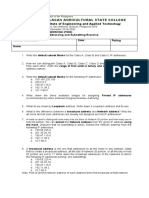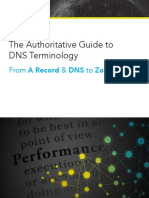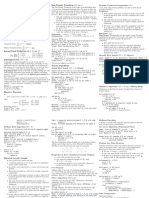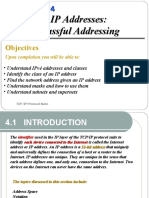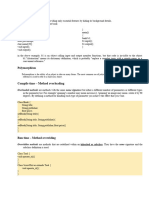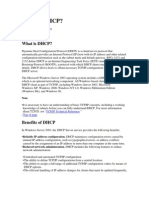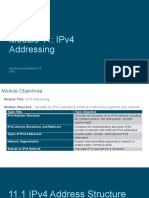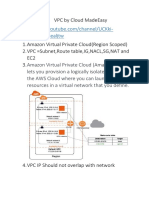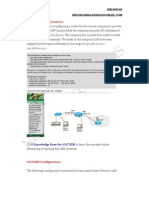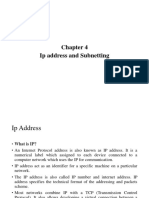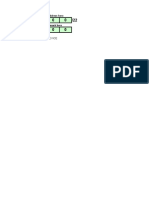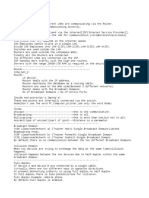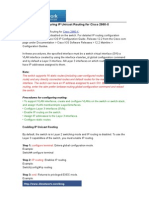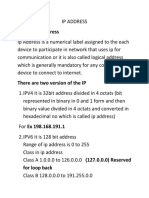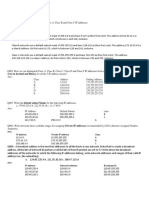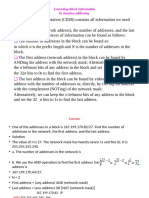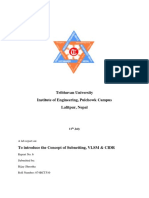Designing an IP Address
Scheme
�Recap
• Python
• Socket Programming
• Assignments
�Objective
• To design an IP address scheme for a network topology according to
network specifications
�What is an IP Address?
• An IP address is a unique address use to identify a device on an IP
network.
• The address consist of 32 binary bits, which can be divisible into a
network and host portion with the help of a subnet mask.
• The binary bits are broken into four octets (one octet = 8 bits). Each
octet is convert to decimal and separate by a period (dot).
• For this reason, an IP address express in dotted decimal format (for
example, 172.16.81.100).
�What is an IP Address? (Cont.)
• The value in each octet ranges from 0 to 255 decimal, or 00000000 -
11111111 binary. I.e. an IP address represented in both binary and
decimal.
10. 1. 23. 19 (decimal)
00001010.00000001.00010111.00010011 (binary)
0 0 0 0 0 0 0 0
128 64 32 16 8 4 2 1
�Classification of an IP Address
• An IP address provide an addressing scheme that can accommodate
large and small networks. There are five different classes of networks,
A to E.
• This class focuses on addressing classes A to C, since classes D and E
are reserved and discussion of them is beyond the scope of this lab.
• Note: Also, note that the terms "Class A, Class B" and so on are used
in this document to help facilitate the understanding of IP addressing
and sub netting.
• These terms are rarely use in the industry anymore because of the
introduction of classless inter-domain routing (CIDR).
�IP Classification
• Given an IP address, its class can be determined from the three high-
order bits. Figure 1 shows the significance in the three high order bits
and the range of addresses that fall into each class.
�Fig
1.
�Class A
• In a Class A address:
• the first octet is the network portion.
• Class A example in Figure 1 has a major network address of 1.0.0.0 -
127.255.255.255.
• Octets 2, 3, and 4 (the next 24 bits) are for the network manager to divide
into subnets and hosts as he/she sees fit.
• Class A addresses are used for networks that have more than 65,536 hosts
(actually, up to 16777214 hosts!).
�Class B
• In a Class B address:
• the first two octets are the network portion
• Class B example in Figure 1 has a major network address of 128.0.0.0 -
191.255.255.255.
• Octets 3 and 4 (16 bits) are for local subnets and hosts.
• Class B addresses are use for networks that have between 256 and 65534
hosts.
�Class C
• In a Class C address:
• The first three octets are the network portion.
• The Class C example in Figure 1 has a major network address of 192.0.0.0 -
233.255.255.255.
• Octet 4 (8 bits) is for local subnets and hosts - perfect for networks with less
than 254 hosts.
�Network Mask
• A network mask helps you know which portion of the address
identifies the network and which portion of the address identifies the
node.
• Class A, B, and C networks have default masks, also known as natural
masks, as shown here:
• Class A: 255.0.0.0
• Class B: 255.255.0.0
• Class C: 255.255.255.0
�Network Mask (Cont.)
• An IP address on a Class A network that has not been sub netted
would have an address/mask pair similar to: 8.20.15.1 255.0.0.0.
• To see how the mask helps you identify the network and node parts
of the address, convert the address and mask to binary numbers.
8.20.15.1 = 00001000.00010100.00001111.00000001
255.0.0.0 = 11111111.00000000.00000000.00000000
�Network Mask (Cont.)
• Once you have the address, the mask represented in binary, then
identifying the network, and host ID is easier.
• Any address bits which have corresponding mask bits set to 1
represent the network ID.
• Any address bits that have corresponding mask bits set to 0 represent
the host ID.
8.20.15.1 = 00001000.00010100.00001111.00000001
255.0.0.0 = 11111111.00000000.00000000.00000000
Net-id = 00001000 = 8
Host-id = 00010100.00001111.00000001 = 20.15.1
�Understanding Subnetting
• Subnetting is the process of taking a network and splitting it into smaller
networks, known as subnets. It's used to free up more public IPv4
addresses and segment networks for security and easier management.
• Sub netting allows you to create multiple logical networks that exist
within a single Class A, B, or C network.
• If you do not subnet, you are only able to use one network from your
Class A, B, or C network, which is unrealistic.
• Each data link on a network must have a unique network ID, with every
node on that link being a member of the same network.
• If you break a major network (Class A, B, or C) into smaller subnetworks,
it allows you to create a network of interconnecting subnetworks.
�Example
• In order to subnet a network, extend the natural mask using some of
the bits from the host ID portion of the address to create a
subnetwork ID.
• For example, given a Class C network of 204.17.5.0 which has a
natural mask of 255.255.255.0, you can create subnets in this
manner:
• 204.17.5.0 - 11001100.00010001.00000101.00000000
• 255.255.255.224 - 11111111.11111111.11111111.11100000
�Example (Cont.)
• By extending the mask to be 255.255.255.224, you have taken three
bits (indicated by "sub") from the original host portion of the address
and used them to make subnets.
• With these three bits, it is possible to create eight subnets. With the
remaining five host ID bits, each subnet can have up to 32 host
addresses, 30 of which can actually be assigned to a device since host
ids of all zeros or all ones are not allowed (it is very important to
remember this).
�Created Subnets
204.17.5.0 255.255.255.224 host address range 1 to 30
204.17.5.32 255.255.255.224 host address range 33 to 62
204.17.5.64 255.255.255.224 host address range 65 to 94
204.17.5.96 255.255.255.224 host address range 97 to 126
204.17.5.128 255.255.255.224 host address range 129 to 158
204.17.5.160 255.255.255.224 host address range 161 to 190
204.17.5.192 255.255.255.224 host address range 193 to 222
204.17.5.224 255.255.255.224 host address range 225 to 254
�NOTE!!!
• There are two ways to denote these masks. First, since you are using
three bits more than the "natural" Class C mask, you can denote these
addresses as having a 3-bit subnet mask.
• Or, secondly, the mask of 255.255.255.224 can also be denoted as /27
as there are 27 bits that are set in the mask.
• This second method is used with CIDR. With this method, one of
these networks can be described with the notation prefix/length.
• For example, 204.17.5.32/27 denotes the network 204.17.5.32
255.255.255.224. When appropriate the prefix/length notation is use
to denote the mask throughout the rest of this document
�Exercise
• Given the Class C network of 204.15.5.0, subnet the network in order
to create the network in Figure 3 with the host requirements shown.
�Exercise
• Subnet Mask ?
• Ranges of the IP addresses?
�Solution
• Looking at the above network figure, you can see that you are
required to create five subnets. The largest subnet must support 28
host addresses. You can start by looking at the subnet requirement. In
order to create the five needed subnets you would need to use three
bits from the Class C host bits. Two bits would only allow you four
subnets.
• Since you need three subnet bits that leaves you with five bits for the
host portion of the address. How many hosts does this support? 25 =
32 (30 usable). This meets the requirement. Therefore, you have
determined that it is possible to create this network with a Class C
network
�Solution (Cont.)
• An example of how you might assign the subnetworks is:
Net-A: 204.15.5.0/27 host address range 1 to 30
Net-B: 204.15.5.32/27 host address range 33 to 62
Net-C: 204.15.5.64/27 host address range 65 to 94
Net-D: 204.15.5.96/27 host address range 97 to 126
Net-E: 204.15.5.128/27 host address range 129 to 15








